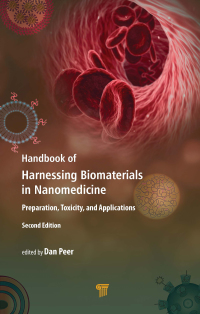Buy Handbook of Harnessing Biomaterials in Nanomedicine: Preparation, Toxicity, and Applications 2nd Edition PDF ebook by author Dan Peer – published by Jenny Stanford Publishing in 2021 and save up to 80% compared to the print version of this textbook. With PDF version of this textbook, not only save you money, you can also highlight, add text, underline add post-it notes, bookmarks to pages, instantly search for the major terms or chapter titles, etc.
You can search our site for other versions of the Handbook of Harnessing Biomaterials in Nanomedicine: Preparation, Toxicity, and Applications 2nd Edition PDF ebook. You can also search for others PDF ebooks from publisher Jenny Stanford Publishing, as well as from your favorite authors. We have thousands of online textbooks and course materials (mostly in PDF) that you can download immediately after purchase.
Note: e-textBooks do not come with access codes, CDs/DVDs, workbooks, and other supplemental items.
eBook Details:
Full title: Handbook of Harnessing Biomaterials in Nanomedicine: Preparation, Toxicity, and Applications 2nd Edition
Edition: 2nd
Copyright year: 2021
Publisher: Jenny Stanford Publishing
Author: Dan Peer
ISBN: 9789814800907, 9781000173680
Format: PDF
Description of Handbook of Harnessing Biomaterials in Nanomedicine: Preparation, Toxicity, and Applications 2nd Edition:
The third volume of the Handbook of Polyhydroxyalkanoates (PHA) focusses on the production of functionalized PHA bio-polyesters, the post-synthetic modification of PHA, processing and additive manufacturing of PHA, development and properties of PHA-based (bio)composites and blends, the market potential of PHA and follow-up materials, different bulk- and niche applications of PHA, and the fate and use of spent PHA items. Divided into fourteen chapters, it describes functionalized PHA and PHA modification, processing and their application including degradation of spent PHA-based products and fate of these bio-polyesters during compositing and other disposal strategies. Aimed at graduate students and professionals in Polymer science, chemical engineering and bioprocessing, it: Covers current state of the art in the development of chemically modifiable PHA including mult-istep modifications of isolated biopolyesters, short syntheses of monomer feedstocks and so forth. Describes design of functionalized PHA-based polymeric materials by chemical modification . Illustrates preparation of bioactive oligomers derived from microbial PHA and synthetic analogues of natural PHA oligomers. Discusses processing and thermomechanical properties of PHA. Reviews advantages of PHA against other bio-based and conventional polymers with current applications and potential uses of PHA-based polymers highlighting innovative products.





